
Rosheen Kaul and Joanna Hu grew up between two worlds. They immigrated to Australia as children, their families were both of mixed Asian heritage, touches of China, Singapore Indonesia, Kashmir, blending with a 1990s Melbourne that was very different from the Melbourne of today.
"I was, at one point, the only non-Anglo-Saxon kid in the primary school," says Hu, co-author of Chinese-ish.
"Growing up between two cultures is a confusing process of reconciling the aspects of each one that you find familiar and comforting with those you want to reject."
Food was a huge part of this for Hu, and Kaul. They wanted to forge their own path where flavour and the freedom to choose trumped authenticity.
The result is Chinese-ish, a wonderful book which celebrates the best of what food is about. Taking recipes you love, ones that you're familiar with, and twisting them a little to suit where life is now.
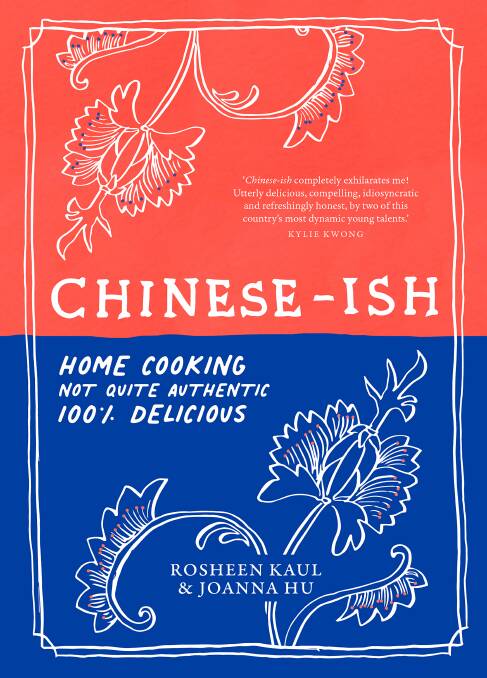
Kaul feels privileged to be surrounded by so many cultures.
"And eating is the easiest way to cross cultural barriers, as so much can be communicated on a plate," she says.
"There are definitely some cheeky recipes in this book. The real 'Chinese-ish' ones that I love are in the section of the book called 'The Rebellion: How to disappoint your parents'. Beijing hot chicken, Sichuan sausage sangas and Sichuan fondue, all recognisable and delicious western snack dishes given some Chinese flavour with cumin spice mix or lashings of chilli oil."
Kaul is the head chef at Melbourne's Etta restaurant. During lockdown she began to document the recipes that she most loved to eat. Hu worked front of house at Vue de Monde, St Crispin and Fat Duck restaurants before settling into a life full of painting and art, her illustrations a fun touch to the margins of the book.
Esteemed chef Kylie Kwong calls Kaul and Hu "two of the country's most dynamic young talents". Kaul lists Kwong as one of her role models, alongside Daniel Bowien, Thi Le, Bo La and Daniel Calvert.
"Many of them cook the food from their cultural heritage via their current location - be it Australia, the United States or Europe," Kaul says.
"The crossover between heritage and sense of place is very important to me, and informs the way I cook at Etta as well."
The pair are on their way to the nation's capital for the Canberra Writers' Festival for an event at aMBUSH Gallery on August 11.
They are keen to check out what the city's food scene has to offer and catch up with old friends.
"I've got a few chef friends in Canberra," says Kaul.
"I'm keen to check out Onzieme, Bar Rochford and Pilot. My friend Mark Glenn is also the executive chef at Pialligo Estate, and I hope I can fit in a tour around the estate when I'm there and see the smokehouse and farm particularly."
The lunch is a part of a big food offering from the festival. Other events include an opening night dinner with Jane and Jimmy Barnes talking about their book Where the River Bends on August 10; chef Karen Martini will talk over lunch about her upcoming book Cook on August 12; on August 13, internet sensation Nat's What I Reckon will get a little saucy; and on August 14, Paul West will talk about all things homegrown.
Sichuan sausage sangas
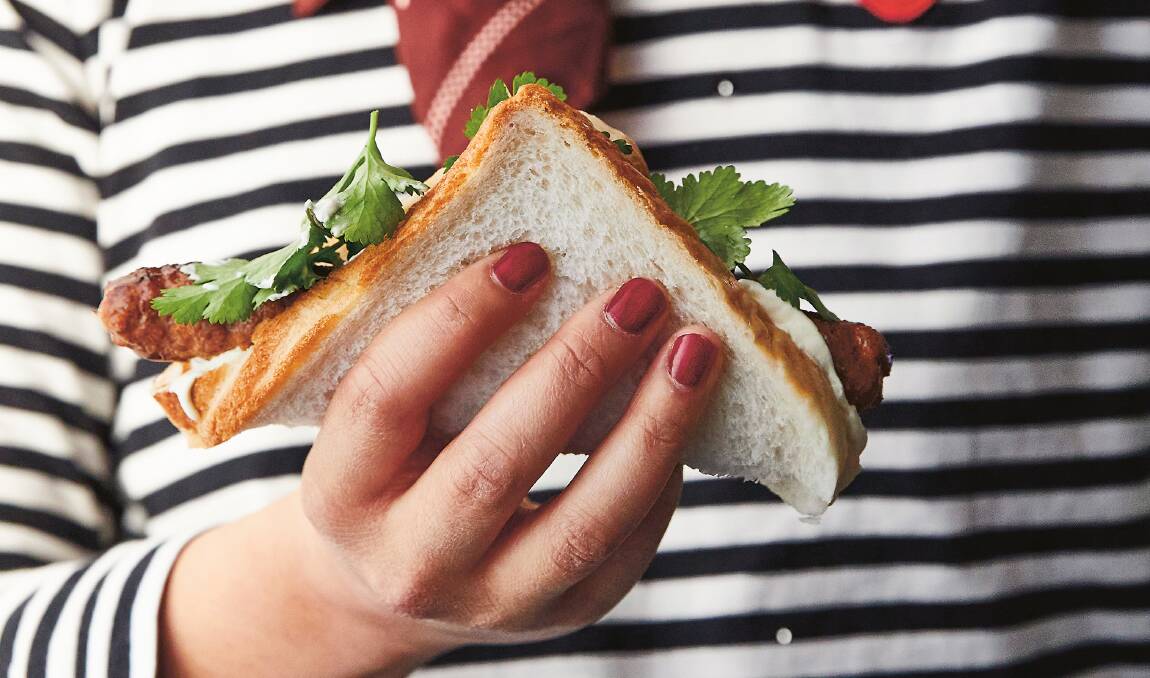
I love a "sausage sizzle", where you can grab a barbecued, slightly singed snag wrapped in soft white bread, in exchange for a gold coin. This recipe keeps the sizzle, the sausage and the white bread, but the similarities end there. Instead, a flavourful, juicy, Sichuan peppercorn-spiced pork sausage is studded with guanciale, smeared with Japanese mayonnaise and refreshed with lime juice. Definitely not your average sausage sanga.
Ingredients
450g pork mince
50g guanciale or pancetta, finely chopped
2 tsp grated ginger
2 tbsp fish sauce
1 tbsp light soy sauce
1 tbsp Dijon mustard
2 tsp caster sugar
1 tbsp cornflour
1 tsp iced water
vegetable oil, for shallow frying
Spice mix:
3 tsp Sichuan or Korean chilli flakes
2 tsp Sichuan peppercorns
1 tsp ground white pepper
1/2 tsp cumin seeds
1/2 tsp coriander seeds
1/2 tsp ground turmeric
To assemble:
4 slices white bread
coriander leaves
mint leaves
Kewpie mayonnaise
lime edges
Method
1. Place the pork mince in the freezer for 30 minutes before using.
2. To make the spice mix, place all of the ingredients in a small frying pan and toast over low heat until very fragrant, taking care not to burn the chilli flakes. If they turn too dark, start again. Set aside to cool, then blitz into a fine powder using a food processor.
3. Add the chilled pork mince, guanciale, ginger, fish sauce, light soy sauce, Dijon mustard, sugar, cornflour and iced water to the spice mix and pulse until combined. The mixture should bounce back when pressed. Refrigerate the sausage mixture for two hours.
4. Using wet hands, roll the sausage mixture into four 2cm x 10cm logs and refrigerate for at least one hour to set.
5. Heat a frying pan over medium heat and add enough vegetable oil to evenly coat the base of the pan. Cook the sausages until they are a deep golden-brown, rolling them around continuously for about 10 minutes.
6. To assemble, wrap the sausages in white bread with a generous handful of fresh herbs, a decent smear of mayonnaise and a good squeeze of lime juice.
Serves 4.
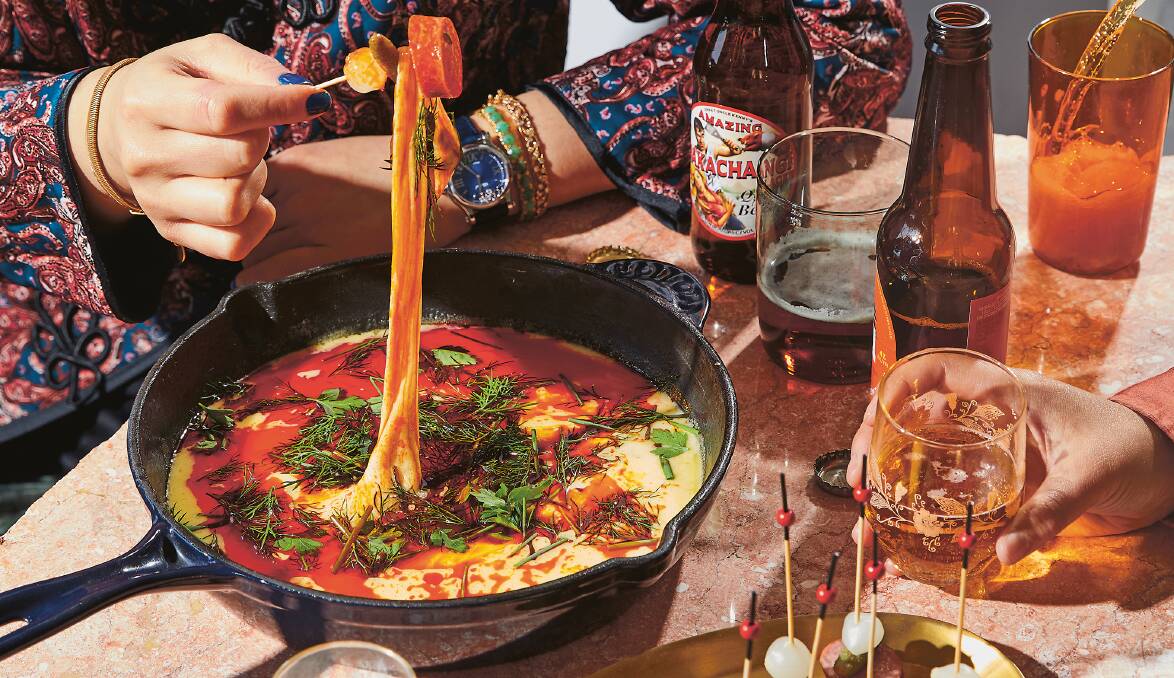
Fiery Sichuan fondue
It's a well-established fact that plenty of people of east Asian descent suffer from lactose sensitivity. And let's be honest - fondue isn't really Chinese in the slightest. So you're probably wondering why there is a fondue recipe in this cookbook. I'm a touch lactose-intolerant myself, but I reckon this recipe is worth the pain.
It might seem simple, being nothing more than cheese and wine melted together, but fondue splits easily. A well-made fondue should be silky-smooth and remain that way, even when heated. For surefire success every time, add cornflour to the mix: it stops the proteins in the cheese from coagulating, guaranteeing your fondue stays smooth and silky.
In this recipe, we use beer instead of the traditional high-acid white wine. Beer is exactly what I'd be drinking with this dish, as the savouriness pairs beautifully with the cheese. As with all popular Sichuan dishes, this fondue is served under a blaze of vibrant red chilli oil.
If you don't have a fancy fondue set-up, use a cast-iron skillet or something similar that retains heat, and pop it back on the stove whenever you need to warm it up. Pile the fondue high with fresh herbs and cracked black pepper, then dip anything your heart desires into it. Fondue is traditionally served with cubes of stale bread, pickled onions and cornichons, but anything that would be improved by being dunked in fiery cheese will do. Just make sure everything is bite-sized.
Ingredients
2 tbsp cornflour
300g Gruyere, grated
300g Comte, grated
2 cloves garlic, minced
300ml lager
1 tbsp lemon juice
1/2 tsp salt
1/2 tsp ground white pepper
100ml chilli oil (see below)
fresh dill, parsley and chives, roughly chopped
cracked black pepper
To serve:
pickled chillies; bread, cut into cubes; hot smoked sausages; charcuterie; boiled potatoes
Method
1. Place the cornflour and cheeses in a bowl and toss to combine. Set aside.
2. Heat the garlic and lager in a pan over low heat and bring to a simmer. Add a handful of the cheese mixture at a time to the simmering beer and whisk vigorously, ensuring each addition is completely melted and emulsified before adding more.
3. Once all the cheese has been added and the mixture is thick and smooth, add the lemon juice, salt and white pepper and stir. If the mixture has turned into a blob of melted cheese with some separated liquid, don't worry. Simply increase the heat and whisk hard to bring it back together.
4. Transfer the cheese mixture to a fondue pot or cast-iron skillet. Dress liberally with the chilli oil, fresh herbs and cracked black pepper. If the fondue starts to set, simply pop it back on the stove and warm it up over low heat.
5. Serve the fondue with pickled chillies, bread, smoked sausages, charcuterie and boiled potatoes, for dipping.
Serves 6.
Chilli oil
The common Chinese name for chilli oil - hong you, or "red oil" - is a reference to its astonishingly vibrant colour. In its purest form chilli oil is made by pouring hot oil over crushed dried chillies and leaving them to infuse. I like mine with heaps of salty sediment, and this recipe ensures the maximum amount of "bits" at the bottom of the jar.
I've divided the recipe into parts for clarity. Try to track down dried Sichuan chillies. If you can't, that's fine, but remember the heat will vary. There are a few varieties available, ranging from moderate to very spicy, and your local Asian grocer should stock at least one of them.
Part 1
40g dried Sichuan chillies, or other dried chillies
2 tbsp vegetable oil
1 tsp Sichuan peppercorns
Part 2
10 fresh red chillies, topped
3 cloves garlic, peeled
3cm piece ginger, peeled
1/4 cup vegetable oil
2 tsp salt
2 tsp caster sugar
Part 3
1 spring onion, white part only
1 1/2 cups vegetable oil
3cm piece ginger, skin on, sliced
2 star anise
1 black cardamom pod
Method
Part 1
1. Use a pair of sharp kitchen scissors to cut the dried chillies into small pieces. Heat the oil in a wok or frying pan and fry the chillies and peppercorns over low heat until they are fragrant and the chillies have turned a deep red. Keep moving the chillies and be extremely careful not to burn them. Allow to cool, then crush using a mortar and pestle. Transfer to a bowl.
Part 2
1. Place the fresh chillies, garlic and ginger in a food processor and blitz to combine.
Warm the oil in a small saucepan and add the chilli mixture. Fry over low heat until the moisture evaporates, five to six minutes. Allow to cool, then stir through the salt and sugar. Combine this mixture with the dried chilli mixture in a heatproof bowl and set aside.
Part 3
1. Cut the white spring onion into large pieces. Don't cut the pieces too small, or they will cook too quickly and burn.
2. Pour the oil into a large saucepan that can hold double its volume (as the oil will bubble up) and place over medium heat. Add the spring onion and ginger and fry until golden, then remove from the oil and discard.
3. Add the star anise and cardamom to the oil and fry over low heat until fragrant. At this point, the oil should be very hot. Pour half the oil over the chilli mixture and stir. Wait five to six minutes for the oil to cool slightly, then pour the remaining oil over the chilli mixture.
4. Once the chilli oil is completely cooled, remove the star anise and cardamom and discard. Cover the oil and leave overnight at room temperature.
5. The next day, the oil should have turned a dark red colour. Pour into a sterilised airtight container or jar and store in a cool dark place for up to three months.
6. Try this chilli oil on avocado and feta toast, on pasta, or mixed with Chinkiang black vinegar and soy sauce for a classic dumpling dipping sauce.
Makes 375 ml.
Cereal butter prawns
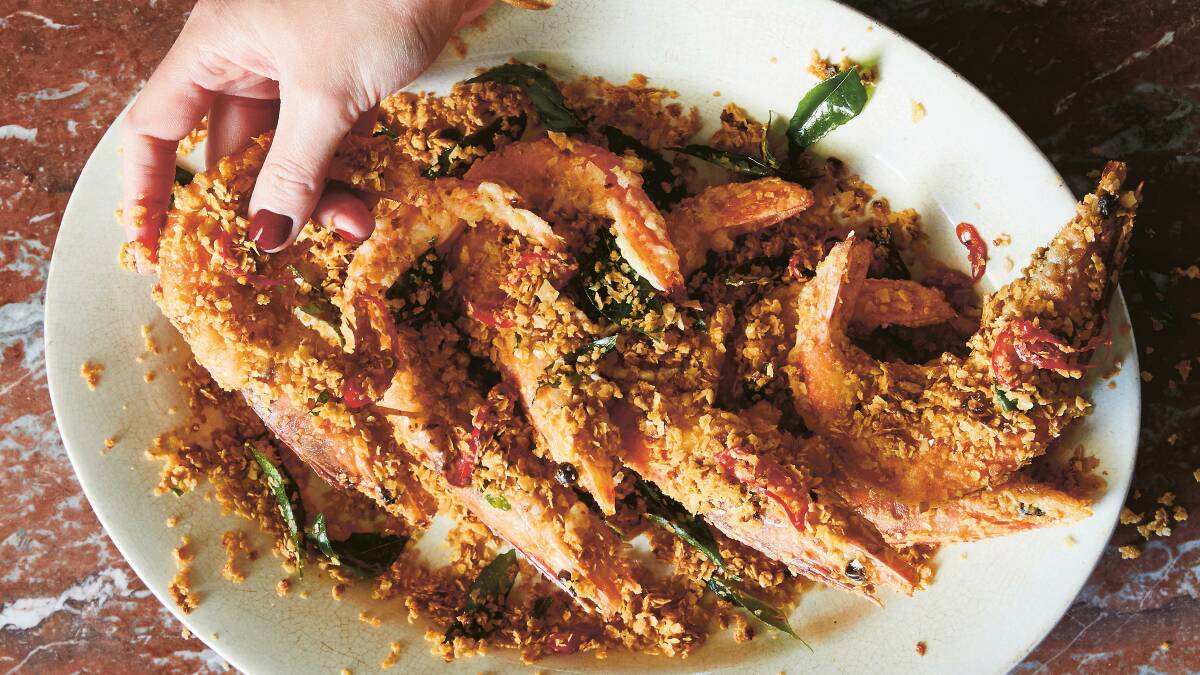
If you associate the word "cereal" with Weet-Bix, Nutri-Grain or Froot Loops, then cereal butter prawns might sound like a pretty horrid concept. In reality, this crunchy, buttery, aromatic savoury dish is another Singaporean zi char favourite. To achieve the crunchy coating, it's customary to use Nestum (a coarsely milled mixed-grain cereal) tossed through butter that has been spiked with birdseye chillies and aromatic curry leaves. It's nice to stick to the original method by keeping the shells on the prawns, as these impart a much deeper flavour. However, you're welcome to peel the prawns before cooking, if you like - just be wary of overcooking them.
Ingredients
500g raw prawns
1 tsp salt
1 tsp caster sugar
1 egg, whisked
2 tbsp plain flour
2 tbsp cornflour
vegetable oil, for shallow frying, plus 1 tbsp extra
1 tbsp milk powder
1 tbsp chicken bouillon powder
1 cup Nestum cereal (see note) or quick oats
30g butter
15 curry leaves
2 birdseye chillies, sliced
Method
1. Use a pair of sharp kitchen scissors to trim the legs and feelers off the prawns. Place the prawns in a bowl and season with the salt and sugar. Pour the whisked egg over the top and toss to coat. Sift the flour and cornflour together over the prawns and stir to combine.
2. In a wok, heat enough oil to shallow-fry the prawns, until smoking. Fry the prawns in batches until crispy, then set aside to drain on a wire rack.
3. Mix the milk powder, chicken bouillon powder and Nestum or oats in a bowl to combine. Heat the extra oil and the butter in a frying pan over medium heat and add the curry leaves and sliced chilli, frying until fragrant. Add the Nestum or oats mixture and toast, continuously stirring, until golden. Add the prawns and toss to coat. Serve hot.
Note: You can find Nestum cereal at most Asian grocers. If you can't find it, use quick oats instead.
Serves 4.
Beijing hot chicken
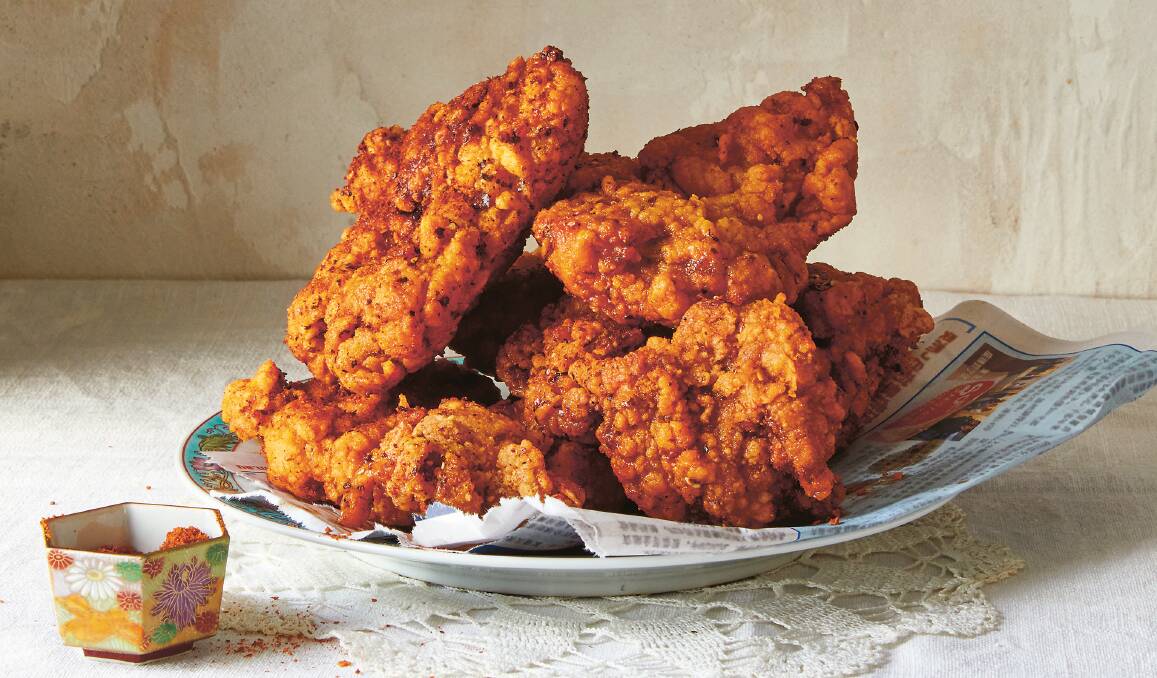
I had a theory: If you put chicken through the same three-day process as Nashville hot chicken (brining, buttermilk brining, and then dredging), but swapped the cayenne, paprika, onion and garlic for a deeply aromatic Northern Chinese spice mix, it could be pretty good. While we're at it, why not use the Korean technique of dredging and frying, too? That could be really good.
It wasn't just good, it was utterly glorious. The potato-starch dredge became an incredibly light and crispy (not hard and crunchy) coating. The double-frying technique was so effective that the chicken was still crispy the next day. The intensity of the spices in the buttermilk brine penetrated right into the chicken, resulting in perfectly seasoned, tender bites. Then, of course, there was the spice mix, that magnificent spice mix. The warm, roasty aromas of cumin, garlic and chilli take you right to the smoky back alleys of Beijing, where this same spice mix is dusted over crisp charcoal-roasted meats.
I also managed to cut a whole day out of the traditional Nashville process by condensing it into two steps. On day one, you make the buttermilk brine and submerge the chicken in it. On day two, you dredge and fry. The spiciness can be adjusted to suit your personal preference, as the chicken is well seasoned even before you coat it in the chilli oil and spice mix. When I make fried chicken at home, I always do half plain, half spicy, so it's not all pain and suffering. I eat my fried chicken between two slices of fluffy white bread, with tiny pickled green chillies, mayo and a wedge of lettuce to cool the burn. How you choose to eat yours is entirely up to you.
Ingredients
vegetable oil, for deep-frying
2 tbsp chilli oil (see here, or use Lao Gan Ma chilli oil)
1 tsp salt
Buttermilk brine:
4 cups buttermilk
2 tbsp salt
2 tsp chicken bouillon powder
1 tsp garlic powder
2 tbsp Sichuan or regular chilli powder
8 skinless chicken thigh fillets
Beijing spice mix:
2 tsp white peppercorns
1 tsp Sichuan peppercorns
3 tsp cumin seeds
1 tsp garlic powder
2 tsp Sichuan or regular chilli powder (see Notes on page 38)
2 tsp chilli flakes
Potato-flour dredge:
1 1/2 cups potato flour
1/2 cup plain flour
1 tsp ground black pepper
1 tsp salt
Method
Day 1
1. To make the buttermilk brine, combine the buttermilk, salt, chicken bouillon powder, garlic powder and chilli powder in a large bowl or container. Ensure the container is deep enough so that the chicken will be completely submerged. Place the chicken thighs into the buttermilk brine, cover and refrigerate for 12-24 hours.
Day 2
1. To make the Beijing spice mix, heat a small frying pan over low heat and toast the white and Sichuan peppercorns and cumin seeds, moving the pan continuously so that the spices toast evenly. When the spices are lovely and aromatic, add the garlic powder, chilli powder and chilli flakes and toast gently for 30 seconds. Allow the spices to cool, then grind them into a coarse powder using a mortar and pestle.
2. To make the potato-flour dredge, combine the potato flour, plain flour, black pepper and salt in a large bowl. Set aside.
3. Heat at least 6cm of vegetable oil in a large heavy-based saucepan to 160C, using a food thermometer to check the temperature. Lift each piece of chicken out of the buttermilk brine and shake off the excess. Thoroughly coat the chicken in the potato-flour dredge, then carefully lower into the oil. Fry the chicken in batches, making sure the pieces don't touch each other or stick to the bottom of the pan. Fry for five to six minutes, until the crust is just set. Transfer to a wire rack to rest while the remaining chicken is fried.
4. When all of the pieces have been fried once, fry each batch a second time, until the coating is extra crispy, six to seven minutes. Potato flour does not brown like plain flour does, so don't attempt to fry until golden. When you tap the coating and it is hard and crisp, the chicken is ready to drain on a wire rack. Reserve 1/2 cup of the hot frying oil.
5. Place two tablespoons of the Beijing spice mix in a heatproof bowl with the reserved frying oil, chilli oil and salt, and mix to combine. Add two chicken pieces to the bowl at a time and toss to coat in the spice and oil mix. Return the chicken to the wire rack and sprinkle generously with the remaining Beijing spice mix. Serve hot.
Serves 4.
- Canberra Writers Festival: Rosheen Kaul and Joanna Hu in conversation with Joanna Savill. A Novel Grazing Lunch presented by Harry Hartog, aMBUSH Gallery and the Canberra Writers Festival. aMBUSH Gallery, Kambri Cultural Centre, noon-2pm, Thursday, August 11. Tickets: $80. canberrawritersfestival.com.au
- Chinese-ish: Home cooking, not quite authentic, 100% delicious, by Rosheen Kaul and Joanna Hu. Murdoch Books. $39.99.


